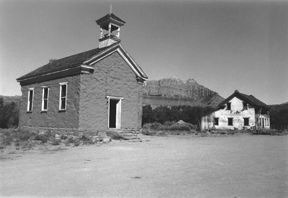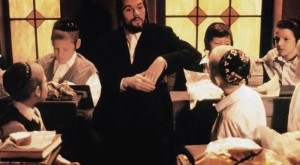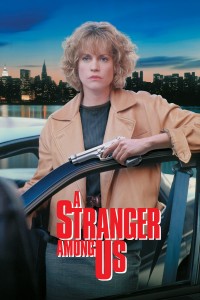From the Chicago Reader (October 2, 1992). — J.R.

NORTH ON EVERS
*** (A must-see)
Directed and written by James Benning.

A good many of the fine points of the film business elude me. But if I understand some of the current rules correctly, it’s poison to use black-and-white cinematography, letterboxing (for framing wide-screen formats on video), or subtitles –unless they appear in music videos or, in the case of subtitles, in Dances With Wolves or The Last of the Mohicans, when they automatically become commercially desirable.
I cite these ridiculous rules of thumb to show just how fanciful most such commercial “rules” turn out to be. Producers, distributors, and exhibitors often claim that their choices are dictated by the well-researched desires of audiences; of course audiences counter that they can only choose from what’s put in front of them. In other words everyone passes the buck when it comes to explaining why black-and-white features can’t get bankrolled in this country and why foreign-language films have a tough time — only 1 percent of all movies shown here are subtitled. And the industry takes enormous pains to ensure that we don’t see letterboxing on TV or video — except on MTV. Read more
From the Chicago Reader (July 1, 1992). — J.R.

There’s apparently something about Hasidic Jews that makes normally talented and reasonable filmmakers — David Mamet in Homicide, screenwriter Robert J. Avrech (Body Double) and director Sidney Lumet here — turn otherwise straightforward thrillers into harebrained hootfests. The best that can be said for this movie, which stars Melanie Griffith as an underground cop who lives with the Hasidim of Brooklyn while trying to solve the murder of a jewel merchant, is that apart from the talents of Griffith and Eric Thal (who plays a young Hasidic Jew she mildly flirts with) it has some educational value as a form of exposition about a fascinating subculture. The worst is that most of the other actors (and characters for that matter) get bent out of shape while trying to conform to the contours of the dotty plot. With John Pankow, Tracy Pollan, Lee Richardson, Mia Sara, Jamey Sheridan, Burtt Harris, and a lot of quotes from the cabala. (JR)

Read more
From the September 15, 1995 issue of Chicago Reader. —J.R.

Films by Marguerite Duras
It’s surely indicative of the scarcity of Marguerite Duras movies that even a dedicated fan like me has managed to see only seven of them — and for one of those I had to drive 100 miles, from Santa Barbara to Los Angeles. No Duras film has been distributed in the United States for years, and in preparing this article I wasn’t even able to obtain a complete filmography; my own provisional list includes 20 titles, stretching from La musica in 1966 to Les enfants in 1982.
If one extends this list by adding adaptations (by herself and others) of Duras literary works, the scripts she wrote for other directors, and two films by Benoit Jacquot revolving around Duras, the figure is 31 films, most of them features. So it’s no small achievement that Facets Multimedia (which, thanks to the efforts of Charles Coleman, has recently featured such adventurous fare as Manoel de Oliveira’s Valley of Abraham and an exhaustive Nanni Moretti retrospective) will be showing a dozen films from this list over the next couple of weeks, most of them in brand-new prints and most of them four to six times. Read more





